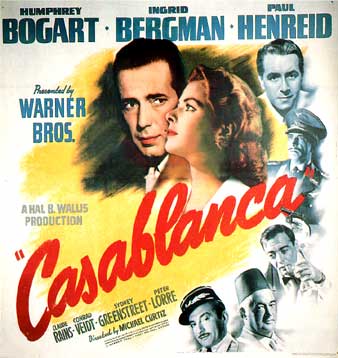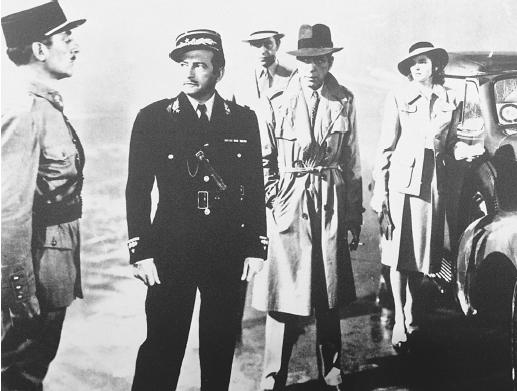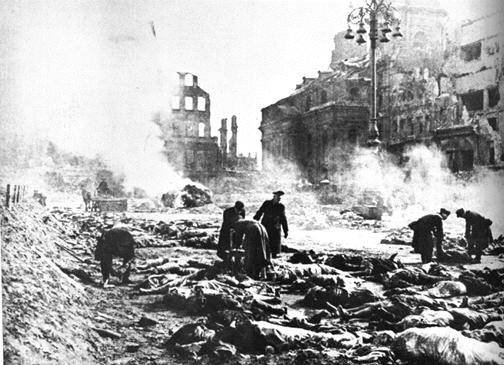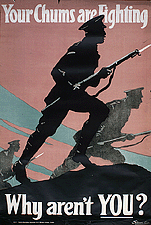Today that long campaign of historical revisionism has concluded with the National War Museum agreeing to revise its Bomber Command display.
And it has resulted in more not less controversy.
Veterans force WWII museum exhibit change
Fighting words rile historians
Historian decries change to war museum exhibit
Beyond dispute
The cowardice and the horror
We owe our freedom to Bomber Command vets
Museum consultation pledge pleases war veterans
Veterans claim victory - Canadian War Museum to change wording on controversial Bomber Command Plaque
A fellow progressive blogger who runs a Canadian History list has opened up discussion on this amongst academic Canadian historians.
What do historians think about the Canadian War Museum controversy?
Of course amongst the Blogging Tories there is the popping of corks and tinkling of toasts in celebration of their Orwellian victory.
Revised does not equal 'Revisionist'
The plaque in question is poorly worded because it purports to be a neutral commentary on Bomber Command but then goes on to draw a negative conclusion about the Canadian air campaign against Germany. The plaque draws a reader's attention to the 'enduring controversy' regarding 'the morality and value' of the air strikes and then wraps up by drawing the conclusion that the raids were ineffective except in their slaughter of innocent civilians. Hansen might believe the conclusion is factual, but then why does the plaque pretend the issue is controversial if this conclusion is unequivocally true?He Who Controls the Present . . .
Historian David Bercuson seems to have summed it up best, "I don't see it as giving in. I see it as correcting something that was unfortunately and badly placed in the first place, and I don't see why anyone shouldn't be given leeway to correct errors."
'Right wing ' historians like David Bercuson who is part of the Calgary School with his pal Barry Cooper , along with their political compatriots in the think tank that created the Reform/Alliance/Conservative party have made Bomber Command their political bugaboo since CBC ran the WWII documentary series; the Valour and the Glory. His opinion appears to have influenced the Senate Committee that raised the issue of the display at the War Museum.
So it's worth noting that the Senate report here identifies the four historians who examined the War Museum text: Serge Bernier (Department of National Defence), Desmond Morton (McGill), Margaret MacMillan (Oxford University) and David Bercuson (University of Calgary). Indeed, that is four experienced and credentialled historians, one actually working in a public museum.
Margaret MacMillan has been very public in condemning the change to the museum's text. I understand Desmond Morton has also publicly defended the integrity of the text as it stands. That would suggest the two experts who endorsed making the change were David Bercuson and Serge Bernier.
Bercuson is not an objective historian in the least, and one with an axe to grind. Far more so than even Jack Granatstein. He is a neo-con hack who along with Cooper has advocated for a right wing shift in Canadian politics.
Neoconservatives criticize social scientists for putting forward ideas that are not necessarily workable, yet the Canadian neoconservatives David Bercuson and Barry Cooper argue that inventive intellectual suggestions are vital to the political system, and that the give and take of politics, and the inherent need to compromise, generally sand down the most unrealistic edges of intellectuals' prescriptions
And they share an advocacy for an Imperial and Imperialist Canadian Military is colored by they right wing politics.
Bercuson and the other Reform Party ilk used the Honor and the Glory segment on Bomber Harris and the Dresden Raids to attack its producers and directors, the McKenna Brothers, along with CBC as being historical revisionists. They claimed, falsely as they still do, that the Honor and the Glory smeared Harris as a war criminal and in doing so slighted the troops who carried out his commands.
Aired on the publicly owned Canadian Broadcasting Corporation, The Valour and the Horror is a Canadian-made documentary about three controversial aspects of Canada's participation in World War II. This three part series caused a controversy almost unprecedented in the history of Canadian television. Canadian veterans, outraged by what they considered an inaccurate and highly biased account of the war, sued Brian and Terrance McKenna, the series directors, for libel. An account of the controversy surrounding The Valour and the Horror with statements by the directors, the CBC Ombudsman and an examination of the series by various historians can be found in Bercuson and Wise's The Valour and the Horror Revisited.
The second episode, "Death by Moonlight: Bomber Command," proved to be the most controversial of the three episodes. It details the blanket bombing of German cities carried out by Canadian Lancaster bombers, including the firestorm caused by the bombings of Dresden and Munich. The McKennas claim that the blanket bombing, which caused enormous casualties among both German civilians and Canadian aircrews, did nothing to hasten the end of the war, and was merely an act of great brutality with little military significance. In particular British commander Sir Arthur "Bomber" Harris is cited for his bloodthirstiness.
What it did was raise the well known public fact that Bomber Harris was hell bent on proving air war worked especially against civilian populations. He had proved it in Iraq!
Yet it was in Iraq that Britain employed its air force for the purpose of suppressing local revolts most widely and for the longest period. Full-scale bombing in Iraq by eight RAF squadrons began in October 1922 and continued until 1932, the year that the British mandatory rule of Iraq officially ceased. Various types of bombs--including delayed and incendiary bombs--were dropped in attacks on villages where militia were believed to be hiding, and in some cases petrol was sprayed over civilian houses in order to intensify the fires ignited by the bombing. Tents and other types of Bedouin dwellings and even their cattle became targets, resulting in the death and injury of many women and children. British Forces justified this indiscriminate bombing by claiming that their operations “proved outstandingly effective, extremely economical and undoubtedly humane in the long run” as they could swiftly put down revolts and riots. One of these RAF squadron leaders in Iraq was Arthur Harris, who later headed the RAF Bomber Command during World War II. Based on their experience in Iraq, the RAF leaders concluded that the best way to defeat the enemy was to conduct "strategic bombing" on civilian dwellings, in particular those of industrial workers.
And that along with the Americans the Brits planned massive fire bombing raids on civilian populations in Germany. The Americans built models cities of Berlin and Tokyo in the Utah desert to test the allies fire bombing theories.
Unfortunately what they found was that fire bombing was not effective, it was not controllable for precision strikes, and it laid wholesale waste to civilian as well as military targets. Knowing this they recognized that it was a not weapon for use except as a final solution, a weapon of mass destruction, to be used as a last resort.
Often contrasted with Britain’s policy of “promiscuous bombing” of urban areas, the United States Army Air Forces entered the fray in 1942 with a precision bombing doctrine that called for the destruction of critical nodes in an adversary’s war economy. Owing to a series of disastrous daylight raids in the summer and fall of 1943, however, American forces implemented a policy of radar bombing through clouds that conserved American aircraft but drastically increased the loss of life among German civilians.
The effects of incendiaries on a city made of paper were soon seen. On the evening of March, 9, 1945 a fleet of over 300 B-29’s flew towards Tokyo containing napalm and cluster bombs. As the bombs burst into flame, aided by the wind, the resulting fires flew across streets and buildings creating a firestorm engulfing the center of the city with flames burning at temperatures exceeding 1,800°F. The heat from the fire created additional winds traveling at velocities of over 40 miles per hour that fed the flames and created thermal winds that were beginning to affect the flight paths of the bombers flying above. Many people attempted to escape the firestorm by jumping into the canals surrounding the city. Of those who did immerse themselves in the canals, most died not from drowning but were either boiled alive when the water began to heat or died from asphyxiation caused by the inhalation of the thick black smoke. Many characterized the conditions within Tokyo that night as a holocaust not knowing that they were witnessing the most destructive fire in human history. Death counts were averaged to be around one hundred thousand with over one million homes and buildings destroyed making this the second most destructive air attack of the entire war next to Hiroshima. Had a significant number of the citizens not already evacuated the city, many more would have lost their lives making the loss of human life in this bombing greater than any other battle or attack in the entire war. This same bombing technique continued until numerous towns, villages, and six of Japan’s seven largest cities had been destroyed.
Dresden was the result of Britain's use of incendiary bombing resulting in hundreds of thousands of civilians dead. The American's on the other hand came up with a much better weapon for mass destruction, a final solution, the weapon of last resort; the Atomic Bomb.
However the mass of deaths of allied forces, the bomber crews themselves occurred before the fatal assault on Dresden. Our men as well as British crews ended up dead because Bomber Harris believed in low level bombing missions. Rather than using height for safety he had his planes fly low and through anti-aircraft fire . Aimed at Dam busting, they resulted in massive losses of life of allied bomber command. Harris considered incendiary bombing as less effective than large scale bombs. The type still used today by American Armed forces.
Night after night tens of precious bombers and their irreplaceable crews failed to return from missions which only managed to damage a house or two and kill the odd cow, as bombs were almost randomly scattered within a huge area usually somewhere vaguely near the intended target. Depressingly often, Bomber Command casualties far outnumbered German casualties on the ground.Harris was hopelessly optimistic when it came to assessing the effectiveness of bombing, making unrealistic claims as to accuracy and destruction, and displaying a remarkable complacency when assessing the effectiveness and failure rate of weapons. He also had an entirely unrealistic view of the overall significance and importance of Bomber Command’s role. He predicted in mid-1942 that it could win the war alone, with a continental land campaign having no use except for mopping up, and describing the ‘entirely defensive’ Coastal Command as ‘merely an obstacle to victory’.
While politicians maintained the pretence that Bomber Command was attacking military and industrial targets Harris was more honest, seeing no shame in attacking the German people and having no problem with describing the aim of his attacks on Berlin as being ‘to cause the heart of the German nation to stop beating’. When pressed to use a higher proportion of incendiaries, he argued the case for high explosive, saying:
I do not agree with this policy. The moral effect of HE is vast. People can escape from fires, and the casualties on a solely fire raising raid would be as nothing. What we want to do in addition to the horrors of fire is to bring the masonry crashing down on top of the Boche, to kill Boche and to terrify Boche.
For that reason, his sacrifice of his own troops and his decision to assault civilian targets, there is a public revulsion of his actions today in Great Britain, except amongst Bomber Command veterans.
Even in wartime Britain, a backlash developed as the extent of the devastation and the number of civilian casualties became known. At the end of the war, all major British commanders were elevated to the peerage except Sir Arthur.
Of course Harris was made a scapegoat for decisions made by those in command of the war, none the less his enthusiasm for the use of bombing to terrorize civilians was his downfall.Unlike other senior officers in the fight against Nazism, Harris was knighted only in 1953, eight years after the war ended. He died embittered in 1984.
Convinced that Harris was treated badly, the 7,500 members of the Bomber Command Association, a British veterans organization, have collected $200,000 to erect a statue of him in London. They want the memorial to stand opposite one of Lord Dowding, commander-in-chief of the Royal Air Force's fighter command, in St. Clement Danes, the RAF church in the Strand.
The Times of London has urged that the project be abandoned, calling Harris a "fanatical believer in the carpet bombing of civilians."
But Bomber Command Association spokesman Ray Gallow insists the statue is appropriate. "When we started area bombing, we were losing on all fronts. The public didn't find a thing wrong with bombing German cities then."
In 1992, a statue to Harris was unveiled near Trafalgar Square in London. Within 24 hours, red paint was poured over it - such was/is the controversy the beliefs of Harris caused.
"It seems to me that the moment has come when the question of bombing German cities simply for the sake of increasing the terror, should be reviewed. Otherwise, we shall come into control of an utterly ruined land." Winston Churchill, 1945 ordering Bomber Command to halt operations over Germany.Harris's defence of himself and Bomber Command is clear-cut and straightforward. It bears and deserves another hearing. In his memoirs, published in 1947, he wrote: 'There is a widespread impression that I not only invented the policy of area bombing but also insisted on carrying it out in the face of natural reluctance to kill women and children felt by everyone else. The facts are otherwise. Such decisions on policy are not in any case made by Commanders-in-Chief in the field but by the Ministries, the Chiefs-of-Staff Committee and by the War Cabinet. The decision to attack large industrial areas was taken long before I became Commander-in-Chief'.
Sir Arthur Harris, who died in 1984, aged 91 felt aggrieved and slighted at the end of his career, not, perhaps, without reason. He complained that he was not consulted or invited to contribute to the official history of the air offensive directly concerned with his own Command. His official dispatch, written in 1945, was placed on the restricted list apparently because the Air Ministry took objection to it. From all this, the author says, it is not hard to infer that the RAF and the political establishment which had supported him during the war later decided to distance themselves from him and the odium created by the bombing offensive in general.
In Canada the right wing use our vets to justify their glorification of this mass murderer and war criminal. They are after all war mongers, and now have their own war in Afghanistan to tout. And that is the reason that the campaign to change the War Museum display is both revisionist and a revulsion.
The bombing of Dresden in World War II, and to a lesser degree the 1943 bombing of Hamburg, and the firebombing of Tokyo remains a source of controversy to this day (though in the case of the latter, the effect on Tokyo's intentionally decentralized subcontractor war industry manufacturers was devastating).The bombing of Dresden, led by the Royal Air Force (RAF) and followed by the United States Army Air Force (USAAF) between February 13 and February 15, 1945, remains one of the more controversial Allied actions of World War II. The exact number of casualties is uncertain, but most historians agree that the firebombing resulted in the deaths of tens of thousands of people. Historian Frederick Taylor says:
“ The destruction of Dresden has an epically tragic quality to it. It was a wonderfully beautiful city and a symbol of Baroque humanism and all that was best in Germany. It also contained all of the worst from Germany during the Nazi period. In that sense it is an absolutely exemplary tragedy for the horrors of 20th century warfare
Firebombing destruction
SPIEGEL ONLINE: Since the war, discussion of World War II war crimes has focused almost exclusively on those committed by the Nazis. But hundreds of thousands of German civilians were also immolated in firestorms created by English and American bombs. Should not Allied excesses be addressed as well?
Taylor: We have to discuss them frankly. There is something inherently fascistoid in air warfare -- you don't see the person you are bombing and killing or injuring and you have this sort of psychopathic gaze from above. The air war is the only part of the war where the Allies, leaving aside the Russians, seriously ran the Axis powers a good race in terms of ruthlessness. But it is now 60 years after the fact, most people involved are dead and we shouldn't start pointing fingers except for in the case of the Holocaust. But the English and especially the Americans have continued since World War II to rely on bombing as an instrument of policy and that really concerns me. I feel uneasy about it. So I think Allied excesses are a legitimate subject for discussion. Absolutely.
SEE:
Vonnegut, Dresden and Canada
Find blog posts, photos, events and more off-site about:
, air warfare, David Bercuson, fire bombing, WWII, Canadian War Museum, Bomber Command,
Bomber Harris, bombing, Canadian Legion, Dresden, WWII Veterans,





















